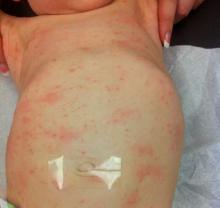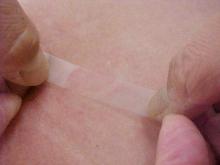NEW YORK – Those paying close attention to the medical literature know that common sealing and packing tapes can be used in the diagnosis of several microorganisms that infect the skin, but an expert delivering clinical pearls at the American Academy of Dermatology (AAD) summer meeting emphasized that this approach deserves both respect and wider application.
Pulling tinea versicolor off the skin by applying and removing clear tape provides a sample after staining “that is easier to see than scraping, and it provides a quick and easy diagnosis,” reported Dr. Stephen P. Stone, professor and director of clinical research, division of dermatology, Southern Illinois University, Springfield.
The value of a 2-inch piece of clear cellophane tape with single-sided adhesive in the diagnosis of tinea versicolor was just one of several examples of how tape can be applied for inexpensive and rapid diagnostic studies. In this case, the tape is applied to the skin to pull off scales and then placed sticky side up on a cover slide so stain can be applied. The stain, although not essential, makes the classic appearance easier to see.
“It takes no time to do this,” said Dr. Stone, who believes “ziti and macaroni” is a better characterization of tinea versicolor than the more common description of spaghetti and meatballs.
For scabies, Dr. Stone upgrades to clear packaging tape that offers greater adhesion than the basic product. He also rubs the tape on the skin to obtain a better sample. Because the packaging tape is wider, he places it across two slides with the sticky side down because there is no stain and the tape is clear so the scabies remain visible under the tape. Again, it is preferable to scraping in many situations simply because it is easier to do.
“It is wonderful with squirming babies because you are not pulling out a scalpel and trying to avoid cutting the skin,” Dr. Stone explained. When scabies are visible, he invites patients and family members to take a look at the mites under the microscope. He said this is often an effective motivator for compliance with therapy, particularly for parents of infants who are reluctant to apply topical scabies therapy effectively across large surface areas.
The tape test can often be used as a simple tool to rule out scabies in infants who have been given a diagnosis of eczema but have failed to respond to therapy. He noted that unrecognized scabies is frequently the actual underlying diagnosis in such cases.
Using tape to diagnose scabies is evidence-based practice, according to Dr. Stone. Citing a study that compared the sensitivity and specificity of dermoscopy, scraping, and tape (Arch Dermatol 2011 Apr;147[4]:468-73), Dr. Stone said that dermoscopy provided the most sensitive tool, but a tape-based diagnosis was the most specific. With tape, “you can actually see the mite, so the diagnosis is definitive,” he added.
Tape also has a role in the diagnosis of pityriasis folliculorum (Demodex), particularly in patients with resistant rosacea, according to Dr. Stone. In his experience, pityriasis folliculorum can either mimic or contribute to rosacea. In either case, effective treatment of the infection will provide a substantial reduction in the erythema that characterizes rosacea. Although he acknowledged that pityriasis folliculorum could be isolated from the face of most individuals, clinicians do not necessarily have to quantify the degree of infection to determine whether it is clinically relevant.
“If they respond to therapy, then they had too many [Demodex mites],” Dr. Stone noted.
These uses for tape for diagnosing and treating dermatologic diseases represented only some examples from a longer list, which includes the use of duct tape to treat common warts.
Dr. Stone reported financial relationships with Abbott, Acuderm, Celgene, Centocor Ortho Biotech, Johnson & Johnson, OPKO Health, Pfizer, Teva, and XOMA Corp.
To compile an authoritative index of tape applications in dermatology, Dr. Stone is interested in the experiences of others, including anecdotal experiences. Examples can be sent to him at sstone@siumed.edu.




